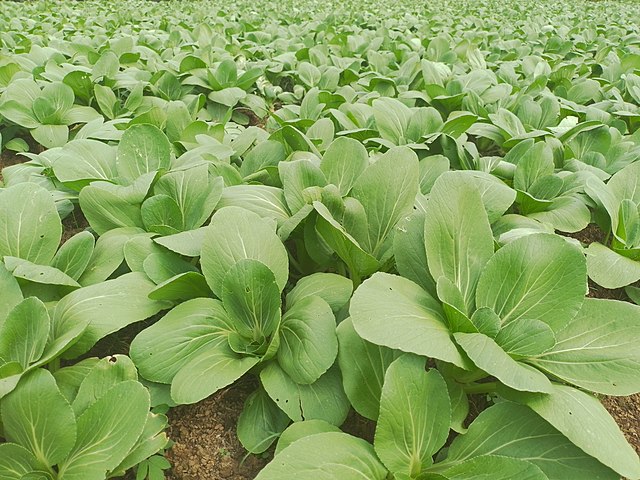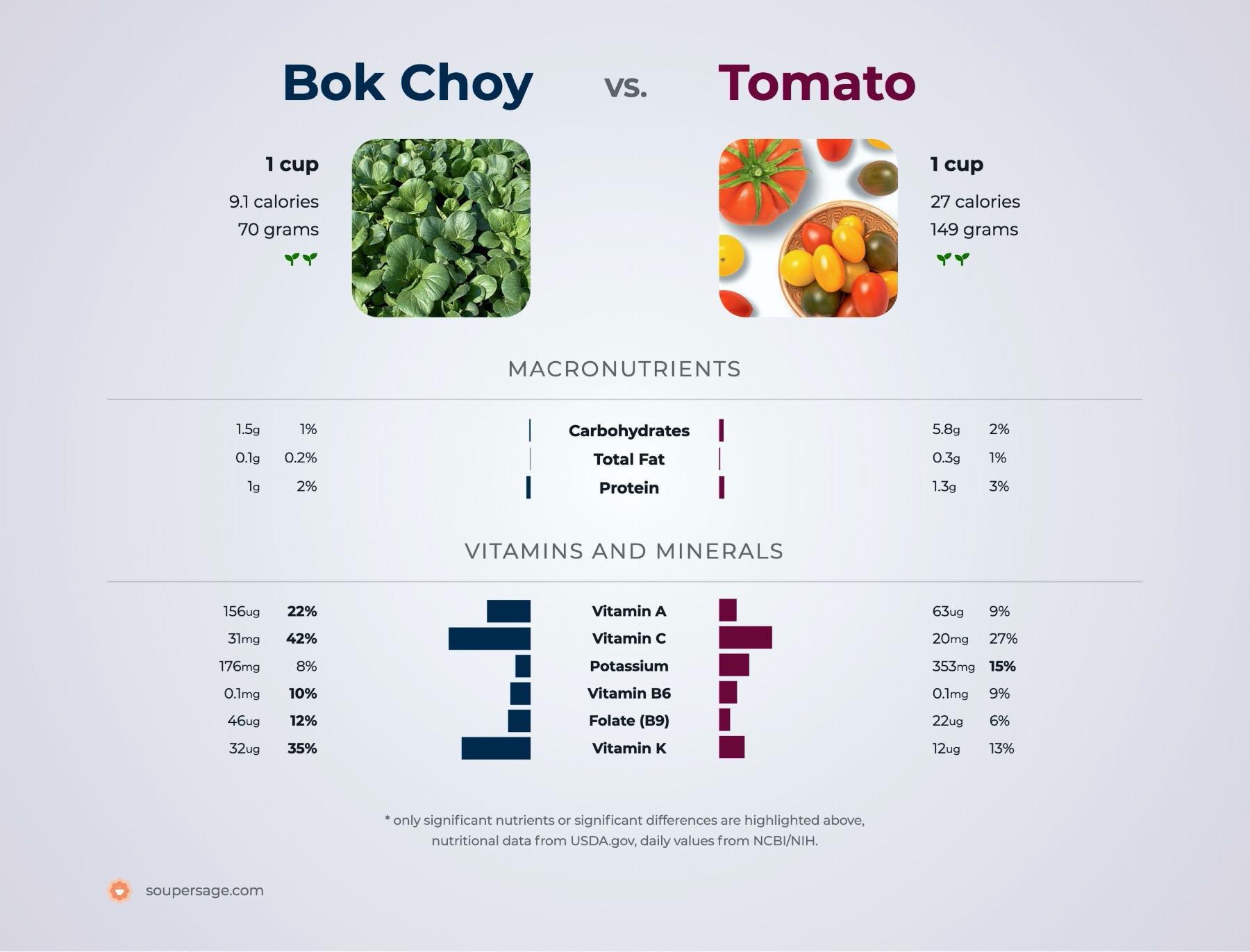Bok Choy vs. Tomato
Nutrition comparison of Bok Choy and Tomato
Ever wonder how your favorite foods stack up against each other in terms of nutrition?
We compared the nutritional contents of
bok choy
versus
tomato
(100g each)
below using 2020 USDA and NIH data[1].
For a quick recap of significant nutrients and differences in bok choy and tomato:
- Both bok choy and tomato are high in Vitamin C and potassium.
- Bok choy has more beta-carotene than tomato, however, tomato contains more alpha-carotene, lutein + zeaxanthin and lycopene than bok choy.
- Bok choy has more riboflavin, Vitamin B6 and folate.
- Bok choy is an excellent source of Vitamin A and calcium.
USDA sources for nutritional information: Bok Choy (Cabbage, chinese (pak-choi), raw) and Tomato (Tomatoes, red, ripe, raw, year round average) . Have a correction or suggestions? Shoot us an email.
Calories and Carbs
calories
Bok choy and tomato contain similar amounts of calories - bok choy has 13 calories per 100 grams and tomato has 18 calories.
For macronutrient ratios, bok choy is much heavier in protein, much lighter in carbs and similar to tomato for fat. Bok choy has a macronutrient ratio of 39:53:8 and for tomato, 17:75:9 for protein, carbohydrates and fat from calories.
Macro Ratios from Calories:
| Bok Choy | Tomato | |
|---|---|---|
| Protein | 39% | 17% |
| Carbohydrates | 53% | 75% |
| Fat | 8% | 9% |
| Alcohol | ~ | ~ |
carbohydrates
Both bok choy and tomato are low in carbohydrates - bok choy has 2.2g of total carbs per 100 grams and tomato has 3.9g of carbohydrates.
The carbs in bok choy are made of 54% sugar and 46% dietary fiber, whereas the carbs in tomato comprise of 69% sugar and 31% dietary fiber.
dietary fiber
Bok choy and tomato contain similar amounts of dietary fiber - bok choy has 1g of dietary fiber per 100 grams and tomato has 1.2g of dietary fiber.
sugar
Bok choy and tomato contain similar amounts of sugar - bok choy has 1.2g of sugar per 100 grams and tomato has 2.6g of sugar.
Protein
protein
Bok choy and tomato contain similar amounts of protein - bok choy has 1.5g of protein per 100 grams and tomato has 0.88g of protein.
Fat
saturated fat
Both bok choy and tomato are low in saturated fat - bok choy has 0.03g of saturated fat per 100 grams and tomato has 0.03g of saturated fat.
Vitamins
Vitamin C
Both bok choy and tomato are high in Vitamin C. Bok choy has 228% more Vitamin C than tomato - bok choy has 45mg of Vitamin C per 100 grams and tomato has 13.7mg of Vitamin C.
Vitamin A
Bok choy is an excellent source of Vitamin A and it has 431% more Vitamin A than tomato - bok choy has 223ug of Vitamin A per 100 grams and tomato has 42ug of Vitamin A.
Vitamin E
Bok choy and tomato contain similar amounts of Vitamin E - bok choy has 0.09mg of Vitamin E per 100 grams and tomato has 0.54mg of Vitamin E.
Vitamin K
Bok choy has 476% more Vitamin K than tomato - bok choy has 45.5ug of Vitamin K per 100 grams and tomato has 7.9ug of Vitamin K.
The B Vitamins
Bok choy has more riboflavin, Vitamin B6 and folate. Both bok choy and tomato contain significant amounts of thiamin, niacin and pantothenic acid.
| Bok Choy | Tomato | |
|---|---|---|
| Thiamin | 0.04 MG | 0.037 MG |
| Riboflavin | 0.07 MG | 0.019 MG |
| Niacin | 0.5 MG | 0.594 MG |
| Pantothenic acid | 0.088 MG | 0.089 MG |
| Vitamin B6 | 0.194 MG | 0.08 MG |
| Folate | 66 UG | 15 UG |
Minerals
calcium
Bok choy is an excellent source of calcium and it has 950% more calcium than tomato - bok choy has 105mg of calcium per 100 grams and tomato has 10mg of calcium.
iron
Bok choy has 196% more iron than tomato - bok choy has 0.8mg of iron per 100 grams and tomato has 0.27mg of iron.
potassium
Both bok choy and tomato are high in potassium. Bok choy has a little more potassium (6%) than tomato by weight - bok choy has 252mg of potassium per 100 grams and tomato has 237mg of potassium.
Antioxidants and Phytonutrients
flavonoids
Naturally occuring in fruits and vegetables, flavonoids are associated with many health benefits and used in a variety of medicinal and pharmaceutical applications. [2][3]
For specific flavonoid compounds, both bok choy and tomato contain small amounts of myricetin.
| Bok Choy | Tomato | |
|---|---|---|
| apigenin | 0.24 mg | ~ |
| luteolin | 0.09 mg | ~ |
| kaempferol | 4.33 mg | 0.09 mg |
| myricetin | 0.03 mg | 0.13 mg |
| Quercetin | 2.06 mg | 0.58 mg |
carotenoids
Carotenoids are micronutrients commonly found in plants and some animal products. An example is beta-carotene, the notable carotenoid which is a popular source of Vitamin A.[4][5]
For specific types of carotenoids, bok choy has more beta-carotene than tomato per 100 grams, however, tomato contains more alpha-carotene, lutein + zeaxanthin and lycopene than bok choy per 100 grams.
| Bok Choy | Tomato | |
|---|---|---|
| beta-carotene | 2681 UG | 449 UG |
| alpha-carotene | 1 UG | 101 UG |
| lutein + zeaxanthin | 40 UG | 123 UG |
| lycopene | ~ | 2573 UG |
Omega-3 and Omega-6
omega 3s
For omega-3 fatty acids, bok choy has more alpha linoleic acid (ALA) than tomato per 100 grams.
| Bok Choy | Tomato | |
|---|---|---|
| alpha linoleic acid | 0.055 G | 0.003 G |
| Total | 0.055 G | 0.003 G |
omega 6s
Comparing omega-6 fatty acids, both bok choy and tomato contain significant amounts of linoleic acid.
| Bok Choy | Tomato | |
|---|---|---|
| linoleic acid | 0.042 G | 0.08 G |
| Total | 0.042 G | 0.08 G |
Customize your serving size
The comparison below is by common portions, e.g. cups, packages. You can also see a more concrete comparison by weight at equal weight (by grams) comparison.
Bok Choy g
()
|
Daily Values (%) |
Tomato g
()
|
|||||
|---|---|---|---|---|---|---|---|
| KCAL % |
|
5% | calories | 5% |
|
KCAL % | |
| G % |
|
5% | carbohydrates | 5% |
|
G % | |
| G % |
|
5% | dietary fiber | 5% |
|
G % | |
| G | 5% | sugar | 5% | G | |||
| G % |
|
5% | total fat | 5% |
|
G % | |
| G % |
|
5% | saturated fat | 5% |
|
G % | |
| G | 5% | monounsaturated fat | 5% | G | |||
| G | 5% | polyunsaturated fat | 5% | G | |||
| G | 5% | trans fat | 5% | G | |||
| MG | 5% | cholesterol | 5% | MG | |||
| MG % |
|
5% | sodium | 5% |
|
MG % | |
| 5% | Vitamins and Minerals | 5% | |||||
| UG % |
|
5% | Vitamin A | 5% |
|
UG % | |
| MG % |
|
5% | Vitamin C | 5% |
|
MG % | |
| IU % |
|
5% | Vitamin D | 5% |
|
IU % | |
| MG % |
|
5% | calcium | 5% |
|
MG % | |
| MG % |
|
5% | iron | 5% |
|
MG % | |
| MG % |
|
5% | magnesium | 5% |
|
MG % | |
| MG % |
|
5% | potassium | 5% |
|
MG % | |
| MG % |
|
5% | thiamin (Vit B1) | 5% |
|
MG % | |
| MG % |
|
5% | riboflavin (Vit B2) | 5% |
|
MG % | |
| MG % |
|
5% | niacin (Vit B3) | 5% |
|
MG % | |
| MG % |
|
5% | Vitamin B6 | 5% |
|
MG % | |
| MG % |
|
5% | pantothenic acid (Vit B5) | 5% |
|
MG % | |
| UG % |
|
5% | folate (Vit B9) | 5% |
|
UG % | |
| UG % |
|
5% | Vitamin B12 | 5% |
|
UG % | |
| MG % |
|
5% | Vitamin E | 5% |
|
MG % | |
| UG % |
|
5% | Vitamin K | 5% |
|
UG % | |
| G % |
|
5% | protein | 5% |
|
G % | |
| UG % |
|
5% | biotin (Vit B7) | 5% |
|
UG % | |
| MG % |
|
5% | choline | 5% |
|
MG % | |
| MG % |
|
5% | chlorine | 5% |
|
MG % | |
| UG % |
|
5% | chromium | 5% |
|
UG % | |
| MG % |
|
5% | copper | 5% |
|
MG % | |
| UG % |
|
5% | fluoride | 5% |
|
UG % | |
| UG % |
|
5% | iodine | 5% |
|
UG % | |
| MG % |
|
5% | manganese | 5% |
|
MG % | |
| UG % |
|
5% | molybdenum | 5% |
|
UG % | |
| MG % |
|
5% | phosphorus | 5% |
|
MG % | |
| UG % |
|
5% | selenium | 5% |
|
UG % | |
| MG % |
|
5% | zinc | 5% |
|
MG % | |
| G | 5% | Water | 5% | G | |||
| G | 5% | Starch | 5% | G | |||
| G | 5% | Alcohol | 5% | G | |||
FAQ
Does bok choy or tomato contain more calories in 100 grams?Bok choy and tomato contain similar amounts of calories - bok choy has 13 calories in 100g and tomato has 18 calories.
Is bok choy or tomato better for protein?
Bok choy and tomato contain similar amounts of protein - bok choy has 1.5g of protein per 100 grams and tomato has 0.88g of protein.
Does bok choy or tomato have more carbohydrates?
By weight, both bok choy and tomato are low in carbohydrates - bok choy has 2.2g of carbs for 100g and tomato has 3.9g of carbohydrates. the carbs in bok choy are made of 50% sugar and 50% dietary fiber, whereas the carbs in tomato comprise of 70% sugar and 30% dietary fiber.
Does bok choy or tomato contain more calcium?
Bok choy is a rich source of calcium and it has 950% more calcium than tomato - bok choy has 105mg of calcium in 100 grams and tomato has 10mg of calcium.
Does bok choy or tomato contain more potassium?
Both bok choy and tomato are high in potassium. Bok choy has a little more potassium ( 10%) than tomato by weight - bok choy has 252mg of potassium in 100 grams and tomato has 237mg of potassium.


